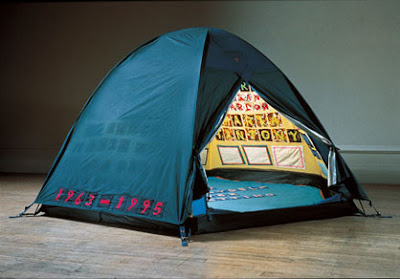Wherefore painting? (part 2)
>> Thursday, October 21, 2010 –
Emin,
paintings,
Ruscha,
Tiger Strikes Asteroid,
writing
(Part 2 of an ongoing essay)
(Matthew Sepielli, Black Book, 2010).
A further question which arises then is why, if the book trope functions to give Sepielli’s works both a physical and psychological skeleton, as well as make it a driver of experience, does not the nearly-as universal trope of a four-sided, rectangular painting surface seem to function as strongly? The history and psychological power of the flat painting surface is even deeper historically and potentially more primeval than even the scribed and bound book. One possible approach to this question is to consider the educational and didactic shift that happened because of (or was occasioned by) the printing press. Before the book’s more universal availability and affordability, production was highly laborious, and the finished products were rare and expensive, therefore only available to the elite (i.e. church; ruling class; etc.) The average citizen could not read. Previous to this, didactics were based on pictures: one of the primary reasons churches were adorned with all the beautiful and lavish painting was for educational means – to instruct the laity in scriptural stories, beliefs and credos. Then came the printing press: Gutenberg’s innovation made the book more affordable, more lightweight and more ubiquitous. From this point on, the heretofore prime didactic tool – the painting (or more correctly picture) – was gradually replaced by the book; at least for the masses. In the six centuries since, the concept and logic of a book (put forward here earlier) became linked directly to not only our sense of narrative and progression, but also education, knowledge and propaganda. Therefore the trope of a book is rooted in the subconscious, in its power to sway, direct and limit one’s absorption of anything related to or reminiscent of that particular group of logic. And of course, Sepielli’s paintings are our pertinent example of that dynamic.
In Black Book, Sepielli takes this idea a step further, and appeals to that by-now ingrained logic more directly. In Black Book, we have a characteristically Sepiellian surface: nearly tar-bound with a protean, rubbery consistency, this painting reads fairly simply, until one reaches (incidentally, by “reading” left to right, Western-style) a shape suggestive of a backwards capital letter B. Now, Sepielli has been utilizing text in various ways in much of his recent work, on both book and non-book pieces, but not normally in quite so direct a way as this; which recalls one of Ed Ruscha’s iconic letter paintings. No longer is it something to be “read” and “interpreted”; here it is more symbolic (as all letters are) and decipherable. B relates to perhaps the title, Black Book, or the original Greek beta, second in command to the alpha – a commentary on a book’s subservience to the author; a painting’s subservience to the artist? The sense of cipher, symbol and icon is heightened by its being filled in (no “gesture” to speak of, such as script has, which would imply human hand, and less autonomy) and its highly-variable and expressive application of palette. It is literally a shape which suggests a letter, rather than vice versa.
(Ed Ruscha, F-house, 1987)
There is one other feature of Black Book which distinguishes it from the other book paintings: it is permanently opened – sealed to this particular spread. This creates an instant ambiguity: we are (book-wise) in the center, yet simultaneously at the end determined by Sepielli. The iconic B then, is afforded even more power, because it becomes a pointer (as it does even by virtue of its shape) to the previous narrative (the alpha) – leaving us to guess at the rest of the narrative, or alphabet, if you will. It is therefore ironically even more of a mystery than the closed books are: having been afforded the sense of “readability” by an ostensibly open book, the conversation and narrative are more titillating than a book of which we are given only the cover/surface. There we are given a surface with the informing logic of a book (trope); here we are made to attempt to read it – that is, approach it as a book rather than a painting – to ultimately little avail. Does Black Book intimate the infamous bachelor’s “little black book”, akin to a Tracey Emin embroidered confessional tent – and leave us wanting and wondering? We cannot be positive; and thus this is a work in control of itself; drawing strength from its limiting (and limits); both revealing and withholding.
(Tracey Emin, Everyone I Have Ever Slept With, 1963--1995, 1994).







